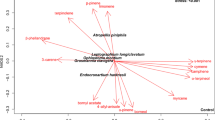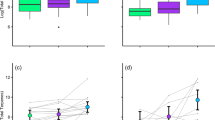Abstract
Mediterranean pine forests are often attacked by caterpillars of Thaumetopoea pityocampa (Lep., Thaumetopoidae), one of the most important defoliators in the Mediterranean region causing large economic losses and ecological effects. The needle terpene concentrations and emissions may play a key role in the defense of pines. We studied two subspecies of Pinus sylvestris, nevadensis (an endemic and relict subspecies) and iberica , with different levels of caterpillar attack in Sierra Nevada mountains (Spain). GC–MS analyses showed large total concentrations of terpenes (6 to 39 mg g−1 of dry weight) in the needles of both subspecies under field conditions. Concentrations were 25 % higher in “Non-Attacked Trees” (NATs) of the iberica than in the nevadensis subspecies. The branches of NATs had terpene concentrations 20 % higher than those of “Attacked Branches of attacked trees” (ABs). Within attacked trees, the “Non-Attacked Branches” (NABs) also had terpene concentrations 20 % higher than those of ABs. Mainly α-pinene and germacrene D had higher concentrations in NATs and NABs than in ABs. Some terpenes had higher concentrations in NABs than in NATs, indicating possible systemic reactions. In subsp. nevadensis, the percentage of monoterpenes relative to total terpenes was higher in ABs than in other attack states. The rates of emission in nevadensis (standardized to 30 °C) were ca. three times higher in ABs than in NABs and NATs. These results suggest that the lower terpene concentrations and high percentages of monoterpenes in ABs were produced by a combination of emission losses and terpene induction in response to herbivorous attack.






Similar content being viewed by others
References
Battisti A, Stastny M, Netherer S, Robinet C, Schopf A, Roques A, Larsson S (2005) Expansion of geographic range in the pine processionary moth caused by increased winter temperatures. Ecol Appl 15:2084–2096
Bauce E, Crepin M, Carisey N (1994) Spruce budworm growth, development and food utilization on young and old Balsam Fir trees. Oecologia 97:499–507
Beyaert I, Kopke D, Stiller J, Hammerbacher A, Yoneya K, Schmidt A, Gershenzon J, Hilker M (2012) Can insect egg deposition ‘warn’ a plant of future feeding damage by herbivorous larvae? Proc R Soc B 279:101–108
Blanch JS, Penuelas J, Llusia J (2007) Sensitivity of terpene emissions to drought and fertilization in terpene-storing Pinus halepensis and non-storing Quercus ilex. Physiol Plant 131:211–225
Blanch JS, Llusia J, Niinemets U, Noe SM, Penuelas J (2011) Instantaneous and historical temperature effects on alpha-pinene emissions in Pinus halepensis and Quercus ilex. J Environ Biol 32:1–6
Blanch JS, Sampedro L, Llusia J, Moreira X, Zas R, Penuelas J (2012) Effects of phosphorus availability and genetic variation of leaf terpene content and emission rate in Pinus pinaster seedlings susceptible and resistant to the pine weevil, Hylobius abietis. Plant Biol 14:66–72
Boratynski A (1991) Range of natural distribution. In: Giertych M (ed) Developments in Plant Genetics and Breeding. pp 19–30
Delphia CM, Mescher MC, De Moraes CM (2007) Induction of plant volatiles by herbivores with different feeding habits and the effects of induced defenses on host-plant selection by thrips. J Chem Ecol 33:997–1012
Faldt J, Solheim H, Langstrom B, Borg-Karlson A-K (2006) Influence of fungal infection and wounding on contents and enantiomeric compositions of monoterpenes in phloem of Pinus sylvestris. J Chem Ecol 32:1779–1795
Gershenzon J, Dudareva N (2007) The function of terpene natural products in the natural world. Nat Chem Biol 3:408–414
Guenther AB, Zimmerman PR, Harley PC, Monson RK, Fall R (1993) Isoprene and monoterpene emission rate variability - model evaluations and sensitivity analyses. J Geophys Res-Atmos 98:12609–12617
Gunasena GH, Vinson SB, Williams HJ, Stipanovic RD (1988) Effects of caryophyllene, caryophyllene oxide, and their interaction with gossypol on the growth and development of Heliothis-virescens (F.) (Lepidoptera: Noctuidae). J Econ Entomol 81:93–97
Hesbacher S, Giez I, Embacher G, Fiedler K, Max W, Trawoger A, Turk R, Lange OL, Proksch P (1995) Sequestration of lichen compounds by lichen-feeding members of the Arctiidae (Lepidoptera). J Chem Ecol 21:2079–2089
Hilker M, Kobs C, Varma M, Schrank K (2002) Insect egg deposition induces Pinus sylvestris to attract egg parasitoids. J Exp Biol 205:455–461
Hodar JA, Zamora R (2004) Herbivory and climatic warming: a Mediterranean outbreaking caterpillar attacks a relict, boreal pine species. Biodivers Conserv 13:493–500
Hodar JA, Zamora R, Castro J (2002) Host utilisation by moth and larval survival of pine processionary caterpillar Thaumetopoea pityocampa in relation to food quality in three Pinus species. Ecol Entomol 27:292–301
Hodar JA, Castro J, Zamora R (2003) Pine processionary caterpillar Thaumetopoea pityocampa as a new threat for relict Mediterranean Scots pine forests under climatic warming. Biol Conserv 110:123–129
Hodar JA, Zamora R, Castro J, Baraza E (2004) Feast and famine: previous defoliation limiting survival of pine processionary caterpillar Thaumetopoea pityocampa in Scots pine Pinus sylvestris. Acta Oecol Int J Ecol 26:203–210
Lamy M (1990) Contact-dermatitis (Erucism) produced by processionary caterpillars (Genus Thaumetopoea). J Appl Entomol 110:425–437
Litvak ME, Monson RK (1998) Patterns of induced and constitutive monoterpene production in conifer needles in relation to insect herbivory. Oecologia 114:531–540
Llusia J, Penuelas J (2000) Seasonal patterns of terpene content and emission from seven Mediterranean woody species in field conditions. Am J Bot 87:133–140
Llusia J, Penuelas J (2001) Emission of volatile organic compounds by apple trees under spider mite attack and attraction of predatory mites. Exp Appl Acarol 25:65–77
Llusia J, Penuelas J, Ogaya R, Alessio G (2010) Annual and seasonal changes in foliar terpene content and emission rates in Cistus albidus L. submitted to soil drought in Prades forest (Catalonia, NE Spain). Acta Physiol Plant 32:387–394
Llusia J, Penuelas J, Seco R, Filella I (2012) Seasonal changes in the daily emission rates of terpenes by Quercus ilex and the atmospheric concentrations of terpenes in the natural park of Montseny, NE Spain. J Atmos Chem 69:215–230
Martin DM, Gershenzon J, Bohlmann J (2003) Induction of volatile terpene biosynthesis and diurnal emission by methyl jasmonate in foliage of Norway spruce. Plant Physiol 132:1586–1599
Mumm R, Hilker M (2006) Direct and indirect chemical defence of pine against folivorous insects. Trends Plant Sci 11:351–358
Nykanen H, Koricheva J (2004) Damage-induced changes in woody plants and their effects on insect herbivore performance: a meta-analysis. Oikos 104:247–268
Ormeno E, Fernandez C, Mevy J-P (2007) Plant coexistence alters terpene emission and content of Mediterranean species. Phytochemistry 68:840–852
Paiva MR, Mateus E, Santos MH, Branco MR (2011) Pine volatiles mediate host selection for oviposition by Thaumetopoea pityocampa (Lep., Notodontidae). J Appl Entomol 135:195–203
Paris CI, Llusia J, Penuelas J (2010) Changes in monoterpene emission rates of Quercus ilex infested by aphids tended by native or invasive Lasius ant species. J Chem Ecol 36:689–698
Pasqua G, Monacelli B, Manfredini C, Loreto F, Perez G (2002) The role of isoprenoid accumulation and oxidation in sealing wounded needles of Mediterranean pines. Plant Sci 163:355–359
Penuelas J, Llusia J (2004) Plant VOC emissions: making use of the unavoidable. Trends Ecol Evol 19:402–404
Penuelas J, Staudt M (2010) BVOCs and global change. Trends Plant Sci 15:133–144
Petrakis PV, Roussis V, Papadimitriou D, Vagias C, Tsitsimpikou C (2005) The effect of terpenoid extracts from 15 pine species on the feeding behavioural sequence of the late instars of the pine processionary caterpillar Thaumetopoea pityocampa. Behav Process 69:303–322
Phillips MA, Croteau RB (1999) Resin-based defenses in conifers. Trends Plant Sci 4:184–190
Sampedro L, Moreira X, Llusia J, Penuelas J, Zas R (2010) Genetics, phosphorus availability, and herbivore-derived induction as sources of phenotypic variation of leaf volatile terpenes in a pine species. J Exp Bot 61:4437–4447
Sampedro L, Moreira X, Zas R (2011) Costs of constitutive and herbivore-induced chemical defences in pine trees emerge only under low nutrient availability. J Ecol 99:818–827
Staudt M, Lhoutellier L (2007) Volatile organic compound emission from hohn oak infested by gypsy moth larvae: evidence for distinct responses in damaged and undamaged leaves. Tree Physiol 27:1433–1440
Steele CL, Crock J, Bohlmann J, Croteau R (1998) Sesquiterpene synthases from grand fir (Abies grandis)—Comparison of constitutive and wound-induced activities, and cDNA isolation, characterization and bacterial expression of delta-selinene synthase and gamma-humulene synthase. J Biol Chem 273:2078–2089
Su JW, Zeng JP, Qin XW, Ge F (2009) Effect of needle damage on the release rate of Masson pine (Pinus massoniana) volatiles. J Plant Res 122:193–200
Tiberi R, Niccoli A, Curini M, Epifano F, Marcotullio MC, Rosati O (1999) The role of the monoterpene composition in Pinus spp. needles, in host selection by the pine processionary caterpillar, Thaumetopoea pityocampa. Phytoparasitica 27:263–272
Trapp S, Croteau R (2001) Defensive resin biosynthesis in conifers. Annu Rev Plant Physio 52:689–724
Vet LEM, Dicke M (1992) Ecology of infochemical use by natural enemies in a tritrophic context. Annu Rev Entomol 37:141–172
Wainhouse D, Staley JT, Jinks R, Morgan G (2009) Growth and defence in young pine and spruce and the expression of resistance to a stem-feeding weevil. Oecologia 158:641–650
Yassaa N, Williams J (2007) Enantiomeric monoterpene emissions from natural and damaged Scots pine in a boreal coniferous forest measured using solid-phase microextraction and gas chromatography/mass spectrometry. J Chromatogr A 1141:138–144
Zhang QH, Schlyter F, Battisti A, Birgersson G, Anderson P (2003) Electrophysiological responses of Thaumetopoea pityocampa females to host volatiles: implications for host selection of active and inactive terpenes. Anz Schadl J Pest Sc 76:103–107
Zovi D, Stastny M, Battisti A, Larsson S (2008) Ecological costs on local adaptation of an insect herbivore imposed by host plants and enemies. Ecology 89:1388–1398
Acknowledgments
We thank the Director of the Sierra Nevada National Park for permission to work in the park and for the use of the facilities. This research was supported by the Spanish Government projects CGL2006-04025/BOS, CGC2010-17172, PROPINOL PN22/2008 and Consolider Ingenio Montes (CSD2008-00040) and by the Catalan Government project SGR 2009-458. Special thanks go to Jordi Sardans, Albert Rivas, David Cruz and Laia Mateu for their collaboration in the samplings and to Rafael Poyatos for technical advice.
Author information
Authors and Affiliations
Corresponding author
Additional information
Communicated by B. Barna.
Rights and permissions
About this article
Cite this article
Achotegui-Castells, A., Llusià, J., Hódar, J.A. et al. Needle terpene concentrations and emissions of two coexisting subspecies of Scots pine attacked by the pine processionary moth (Thaumetopoea pityocampa). Acta Physiol Plant 35, 3047–3058 (2013). https://doi.org/10.1007/s11738-013-1337-3
Received:
Revised:
Accepted:
Published:
Issue Date:
DOI: https://doi.org/10.1007/s11738-013-1337-3




